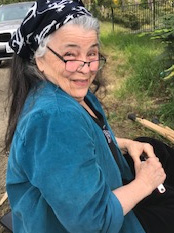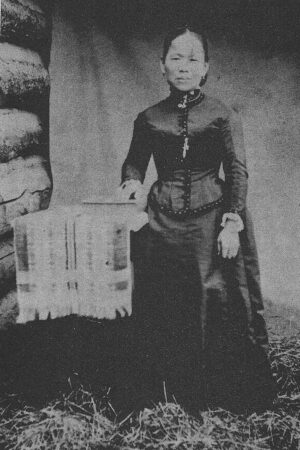
Katy Tahja
Below is a tale of serendipity that illustrates the talents of one of our most enthusiastic (and smart) volunteers – Ms. Katy Tahja. Her ability to bring together seemingly unrelated facts and recall items from years ago make her a great storyteller and one of our most valued supporters.
The chatter in the Kelley House archives sounded something like this…”Does anyone know where this pile of postcards came from? Who gave them to us? They’re OLD! This scenery is not local. What should we do with them?”
This is problem museums sometimes experience when people just drop things off. What we were looking at was a stack of 130 postcards, probably produced from strips of black and white negative film, which featured excellent photography of a journey by boat in a wilderness. Since they did not relate to the Mendocino Coast, they were going to be offered for sale at an up-coming book sale. But I held them back. While it wasn’t our local history, the postcards would be a treasure for a museum someplace else…but where?
Luckily, we had clues. Several cards had the word SALMON penciled on them. I had been on California’s Salmon River in Siskiyou County and these photographs were not taken there. But, having vacationed in Idaho, the terrain and vegetation looked like what I had seen in that place.
The boat shown in the postcards had a crew traveling in what old time logging camp lingo would have been called a “wanigan.” It’s a flat bottom boat with a small cookstove built into a back corner with removable pieces of smokestack chimney stacked beside it. “Wanigans” were portable kitchens to feed loggers on river drives of logs being floated to a sawmill. A plank could be spread across the boat for a worktable and there was a canvas tent that could be erected over it, as seen in one of the images.
Of the 130 postcards, fifteen had people on them. Most were of the crew, but a few were folks met along the voyage. With one single postcard I knew my hunch about Idaho was correct. It was a photo of a Chinese woman named Polly Bemis.

Chinese-American pioneer Polly Bemis in her wedding dress, 1894 (Wikipedia)
As a historian, I have always been interested in the role Chinese immigrants played in the settlement of the American West. While we know they built railroads, worked in mining camps and ran laundries and cook houses they also ended up in some very out-of-the-way places…like Idaho. And if that Chinese person led an interesting life someone might write a book about them. Polly Bemis was such a person.
“Thousand Pieces of Gold” by Ruthanne McCunn is the story of how Polly made the journey from China to the Salmon River. I read it decades ago and researched Bemis more and saw photographs of her. Now, here she was in a Mendocino museum smiling at me from a photo. She died in 1933. The 130 postcards then must be close to 90 years old, so the river journey was made in the 1920s or early 1930s.
I started googling to find the museum closest to her Salmon River home. The Central Idaho Historical Society in McCall was the answer and I e-mailed them to ask if they’d like a donation? “You Betcha.” When the postcards arrive in Idaho they can’t wait to see if they can identify the faces in the photos.
So, 130 postcards were sent off to a new home in Idaho. Museums and historical societies love to support each other with unexpected treasures to share. What may strike someone as useless old stuff (like a 90-year-old pile of postcards from 1,000 miles away) may be a treasure trove to another historical someplace else (like Central Idaho).
Postscript – after the post cards arrived, the historical society members showed them to local old timers, who recognized many of the people and the locations. One photo of a young man with a dead bear was immediately identified as a well-known “scoundrel and coward” on the river.
A few weeks later, we received a nice note, which included a donation, that said, “Thanks to Katy’s knowledge of Polly Bemis and her time and effort in contacting us, these wonderful photos now reside in our archives. They have come home!”